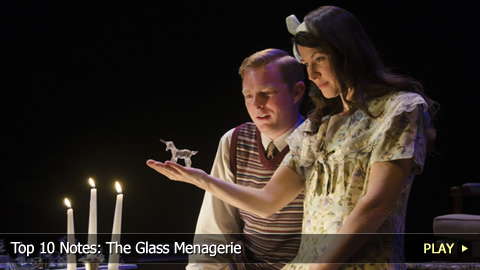Top 10 Notes: The Glass Menagerie

#10: About the Author
Born in 1911 in Columbus, Mississippi, Tennessee Williams published his first short story at 17. After university, he took up multiple jobs while honing his skills as a playwright. He found the most success with “The Glass Menagerie” and “A Streetcar Named Desire.” Though he continued to write, health and personal problems eventually led to his death in 1983.
#9: Influences and Inspirations
Williams’ short story entitled “Portrait of a Girl in Glass” and screenplay called “The Gentleman Caller” serve as the two main sources of inspiration for “The Glass Menagerie.” Williams’ own life also loosely shapes this four-character memory play. For instance, the character of Tom is similar to Williams while Tom’s sister Laura was likely inspired by the writer’s real-life sister Rose.
#8: Settings and Era
As the play’s narrator, it’s Tom Wingfield who recounts his time with his family during 1937. While he’s telling the tale from a future point in time, the main action is based around his memories while living in an apartment in St. Louis.
#7: Plot
Narrated by Tom, who is also the play’s protagonist, “The Glass Menagerie” takes us back to when he worked at a shoe warehouse to support his mother Amanda and his sister Laura. Because Laura has a limp and is extremely shy limp, Amanda worries she won’t get married. Tom brings a colleague named Jim to meet his sister, but things don’t work out. Since he was already unhappy with his life, and then is blamed for the situation with Laura and Jim, Tom ultimately leaves his family.
#6: Tom Wingfield
Tom’s father left many years ago, so Tom feels forced to help his mother and sister. But his job at the shoe warehouse is boring and unfulfilling; he’d rather be a writer. In order to escape from this dull existence, he goes out at night. Though his unhappiness later causes him to leave his family, Tom still expresses affection for his sister.
#5: Amanda Wingfield
Amanda is a single mother trying to take care of her children following the departure of her husband several years ago. She is infatuated with the past, and especially her time as a Southern Belle, because she is unhappy with the present. But she’s very much concerned with the future, specifically that of her children: pushing Tom to be more responsible limp and desiring a husband for Laura.
#4: Laura Wingfield and Jim O’Connor
Though she’s the older sibling, Laura Wingfield is a fragile person with a limp. Instead of dealing with reality, she prefers to retreat into her own world with her glass figurines at the center. She’s as rare and unusual as a blue rose or a unicorn and as delicate as her figurines. Her unselfish personality is in stark contrast with the rest of her family. She’s also the character around which the plot turns. Because her mother wants a man to support her, Laura’s eventually introduced to her brother’s colleague. Jim turns out to be a former high school crush and the only person who’s able to really understand and connect with Laura. However, his engagement to another woman prevents their relationship from progressing any further.
#3: Values and Themes
The main theme of “The Glass Menagerie” explores how strongly memories and living in the past can affect people. The play also deals with what it’s like to feel trapped, as demonstrated by Tom’s unhappiness with his job and living with his family. Yet at the same time, he feels a duty to his family. Other themes dealt with in the play include the effects of denial, the pursuit of dreams and the roles of gender.
#2: Modern Popularity
After finding fans in several critics during its initial Chicago run in 1944, “The Glass Menagerie” helped Williams earn his first taste of success and paved the way for more success with “A Streetcar Named Desire.” The play also spawned multiple stage performances and inspired several parodies.
#1: Adaptations
Though there have been radio productions of the play, the more known adaptations are its onscreen versions. These include the 1950 film with Kirk Douglas and the 1987 Paul Newman-directed flick. But the best-received version is the Emmy-winning 1973 TV movie with Katharine Hepburn and Sam Waterson.
Do you agree with our list? What’s your favorite piece of “The Glass Menagerie” trivia? Be sure to subscribe to WatchMojo.com for more entertaining top 10s.
